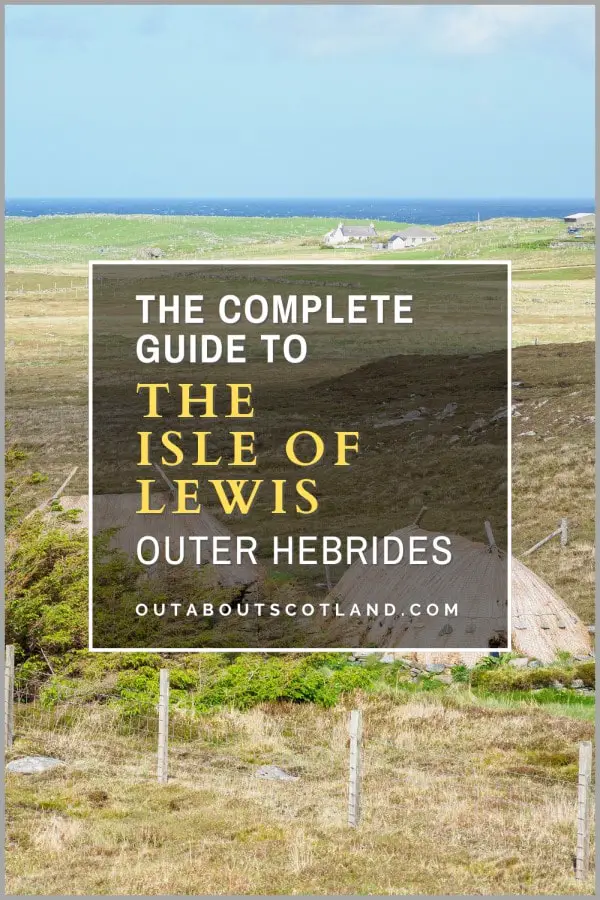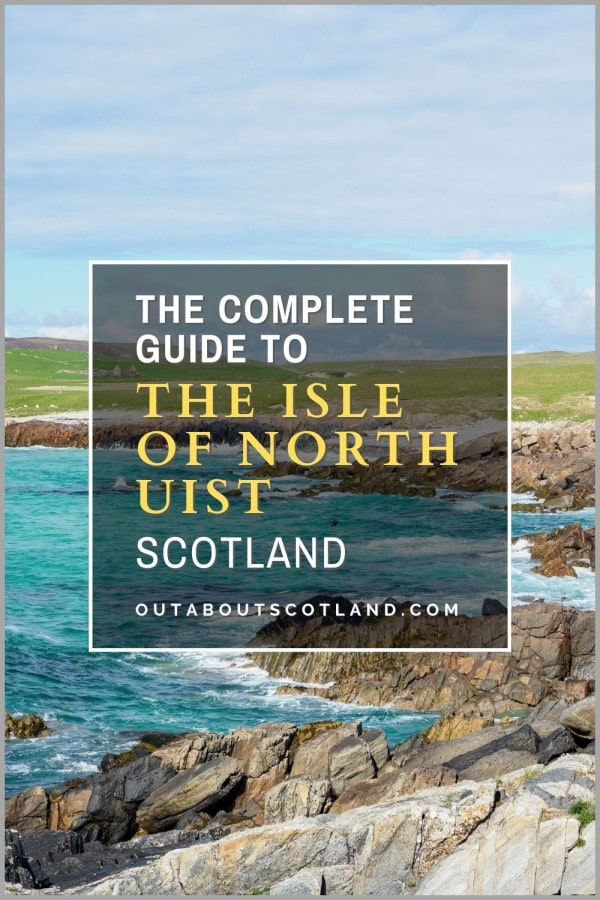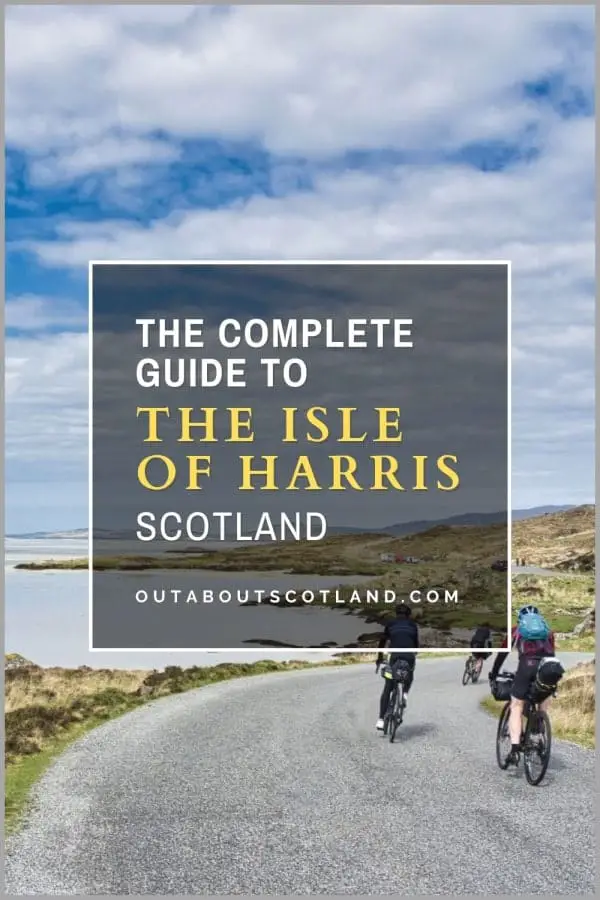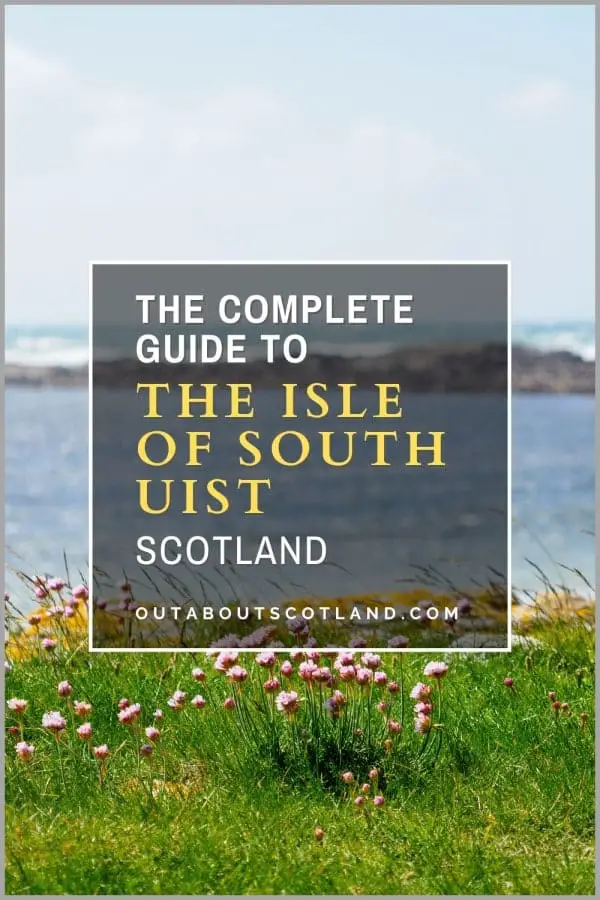If you’re looking for a dream escape to one of the most beautiful places in the world, look no further than Scotland. With its stunning landscapes and rugged coastline, this country is the perfect destination for your next holiday, no matter the time of year.
From the wild and remote islands of the Outer Hebrides to the peaceful and picturesque Inner Hebrides, Scotland is home to some of the most beautiful islands in the world.
In this article, you’ll discover a collection of the most beautiful islands in the Hebrides, all of which are worth considering for your next break, whether you’re looking to explore ancient castles, take in breathtaking views, or simply relax on a beach.
Isle of Skye
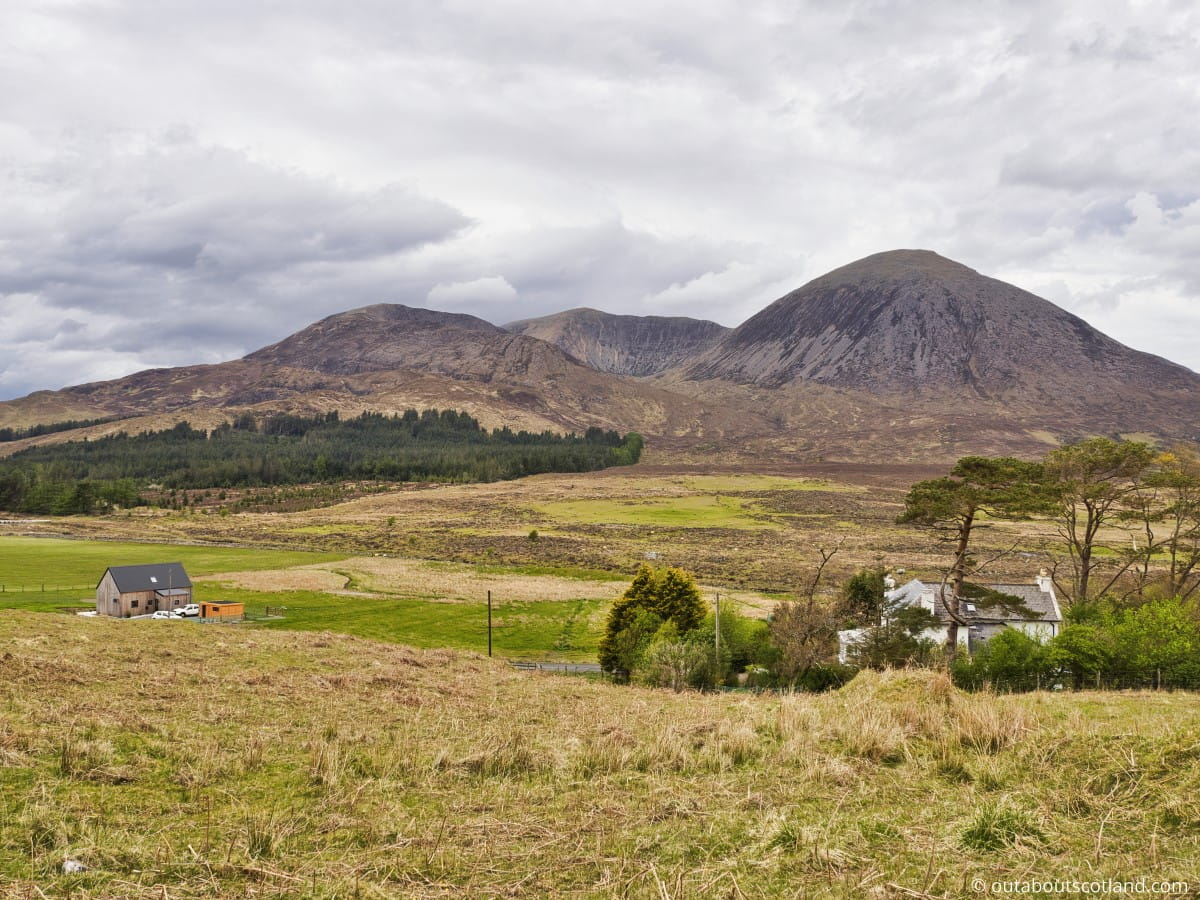
Out About Scotland Guide: Isle of Skye
The Isle of Skye is an enchanting destination situated off the west coast of Scotland. With its charming villages, dramatic landscapes, and incredible wildlife, it is no wonder that Skye attracts hundreds of thousands of visitors each year.
The best way to explore Skye is by car, as the majority of its roads are well-maintained and run to the farthest corners of the island. However, there are also parts of Skye that are so remote they can only be reached by foot, so taking a pair of hiking boots (link to my boot reviews) is highly recommended.
For those who love wildlife, Skye offers some great opportunities for spotting birds and marine animals – especially around the gorgeous Neist Point on the northwest tip of the island and the Quiraing on the northeast side.
The Quiraing is (in my opinion) the most beautiful part of the island thanks to its incredible landscape, but there are lots of other points of interest on Skye including the Fairy Glen and the Fairy Pools, The Storr, and the Red and Black Cuillin mountains.
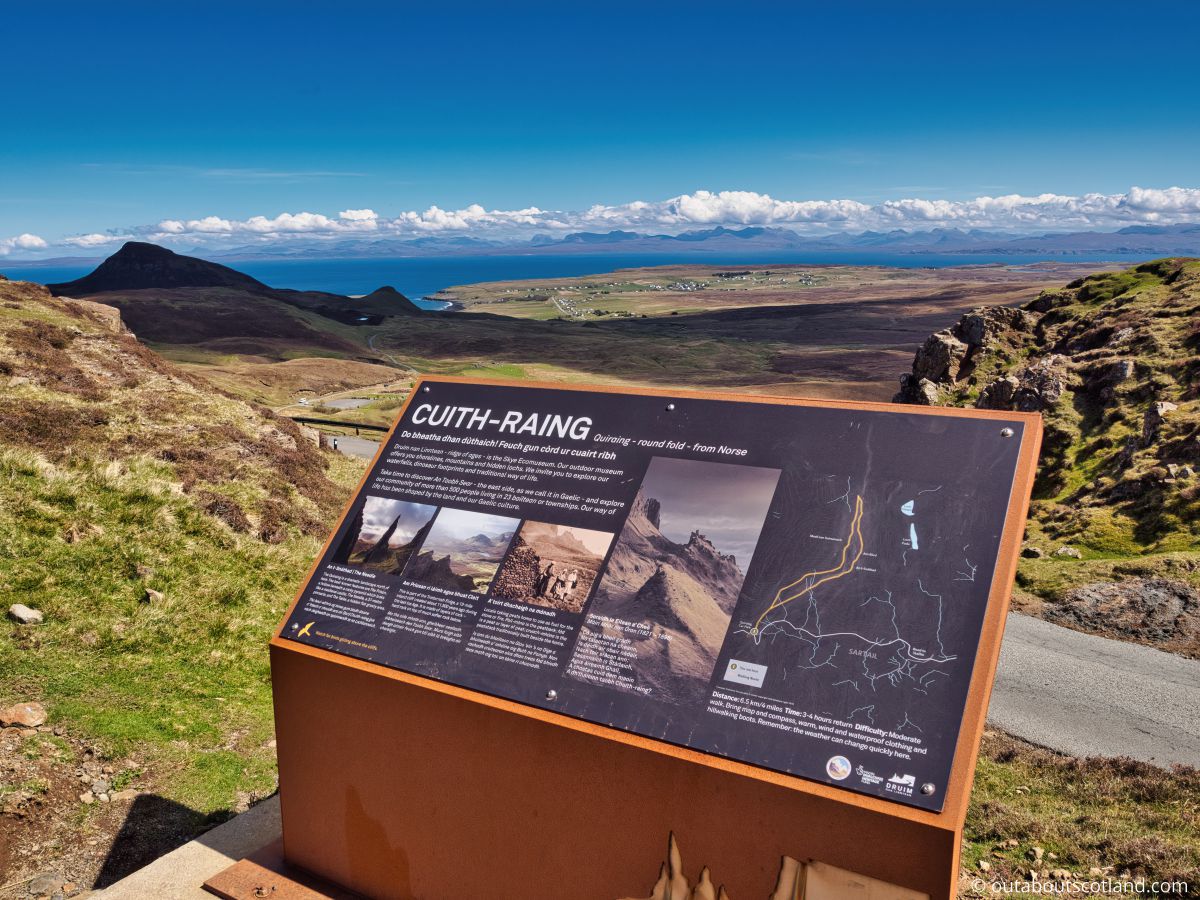
This is the easiest Scottish island to get to thanks to the Skye Bridge, which joins the mainland at Kyle of Lochalsh, which in turn means it’s very, very busy in the summer. Due to the fact that it’s so popular, if you’re thinking of planning a trip to the Isle of Skye, it’s advisable to book your accommodation at least three months in advance, and preferably six months before the date of travel, to avoid seasonal price hikes.
There are many lovely towns and villages to explore on the island, including Portree, Dunvegan, Edinbane, Uig, and Staffin in the north, and Broadford, Armadale, Carbost, Elgol, and Kyleakin in the south. I’ve personally stayed at both Broadford and Portree many times and can vouch for both of them as great places to use as a base to explore the island.
There are lots of ways you can visit the Isle of Skye, but for sheer convenience you won’t go far wrong with the Rabbie’s 3-day mini-coach tour which stops at all the major tourist attractions from Eilean Donan Castle to the Quiraing and the Old Man of Storr, as well as a couple of must-sees including the iconic Loch Ness.
To see more details about this 3-day small-group tour of the Isle of Skye, visit the Rabbie’s website.
Isle of Mull
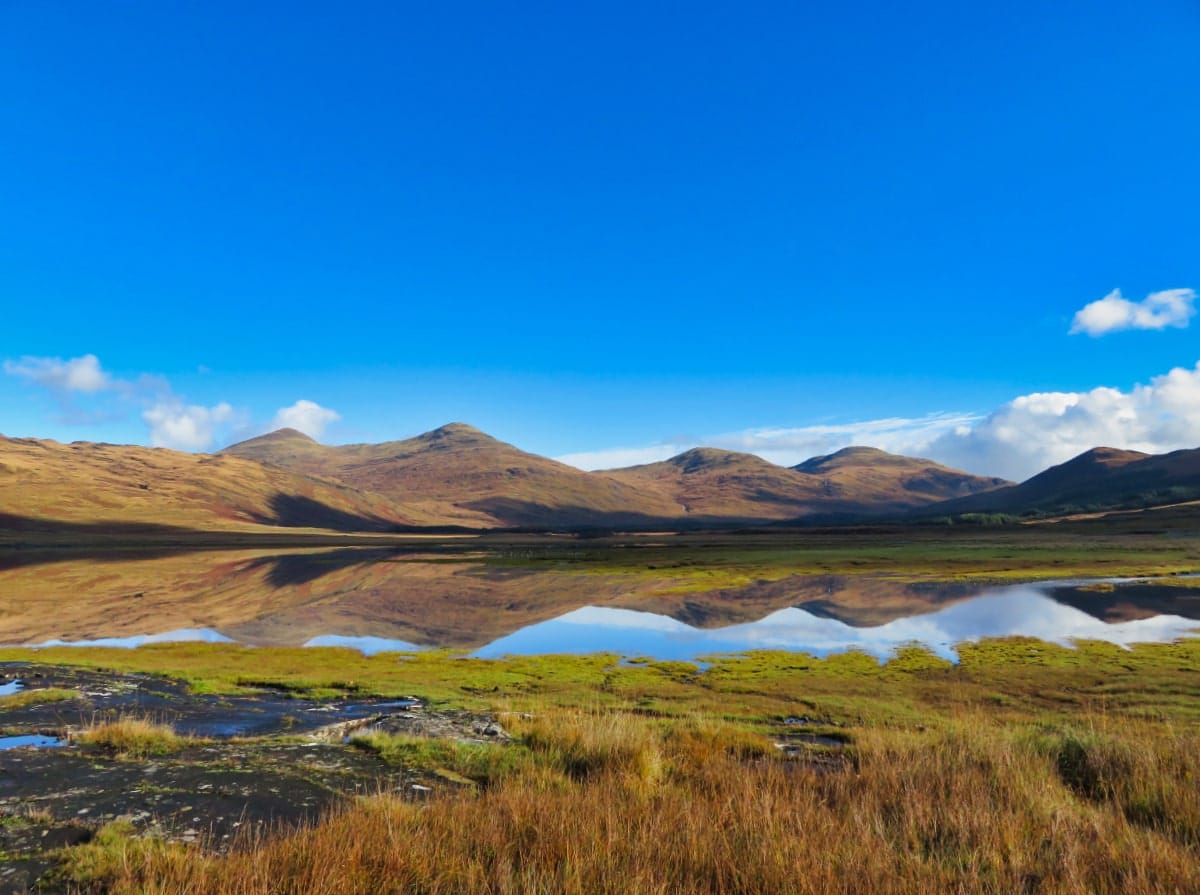
Out About Scotland Guide: Isle of Mull
Mull, the fourth-largest island in the United Kingdom, is located in the Inner Hebrides and is known for its natural beauty and abundance of tourist attractions. Mull has been voted as being one of the best Scottish islands to live on, and it’s easy to see why. It’s a genuinely beautiful island that boasts everything from tranquil beaches to towering peaks, making it a perfect destination for visitors of all ages and interests.
I advise starting your tour of the island at Tobermory – a charming harbour town with a number of attractions such as the Mull Aquarium with its fascinating displays of marine life and tour boats that sail out on wildlife-watching adventures around Tobermory Bay and Calve Island.
Meanwhile, for those seeking a more energetic experience, you might consider making your way to Ben More, the highest peak on Mull. The views from the summit are breathtaking and offer an unparalleled opportunity to admire the island.
With several different routes to choose from, you can explore the landscape of Ben More on trails that are either challenging (south side) or straightforward (north side).
The marine wildlife of Mull is also something to behold. Seals, otters, dolphins, and even whales are frequently spotted around the island’s waters, while the interior is home to herds of red deer, which are amazing to watch at any time but especially so during rutting season (September to November).
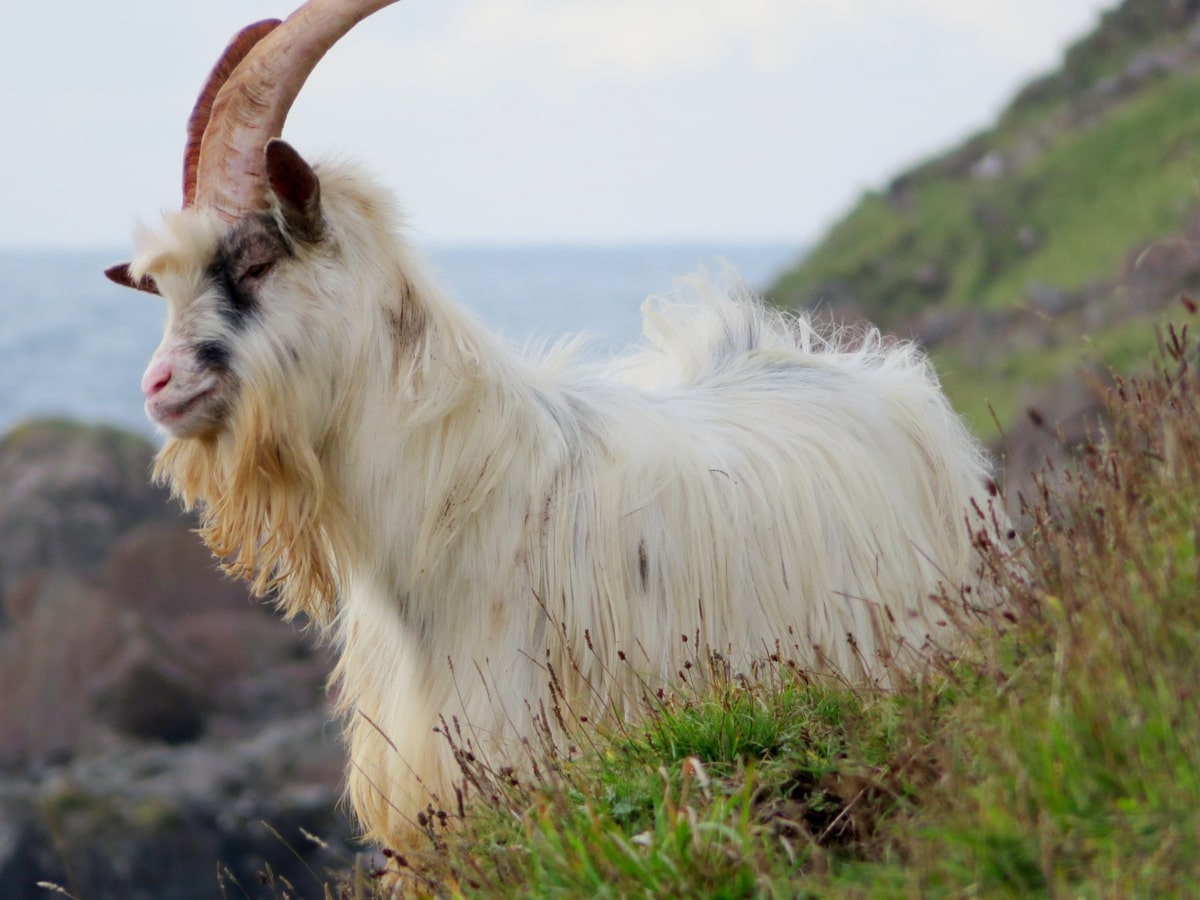
When you’re ready for more sightseeing, hop on a boat and head to the Isle of Iona to see Iona Abbey, the first Christian church built in Scotland. The abbey is home to a wide variety of stone carvings, and Iona itself is a gorgeous place with secluded beaches and footpaths that thread their way into the back and beyond.
Mull’s beautiful scenery, varied landscape, and endless supply of open spaces mean it’s a destination suitable for any traveller. To make the most of a visit to Mull, you really need to know where to go and what to see—something that isn’t easy for first-time visitors.
With that in mind, you might like to book a tour with an experienced guide who’ll drive you to all the highlights while telling you stories about the landscape and the history of this stunning island.
The Rabbie’s Mull and Iona tour starts at Glasgow (just 1 hour from Edinburgh) and heads through Loch Lomond National Park before hopping over to Mull via the historic town of Oban. You’ll then see Iona Abbey, Fingal’s Cave, and Tobermory – all absolute must-dos for any visitor to Mull.
For more information, take a look at the Rabbie’s Mull and Iona tour page.
Isle of Tiree
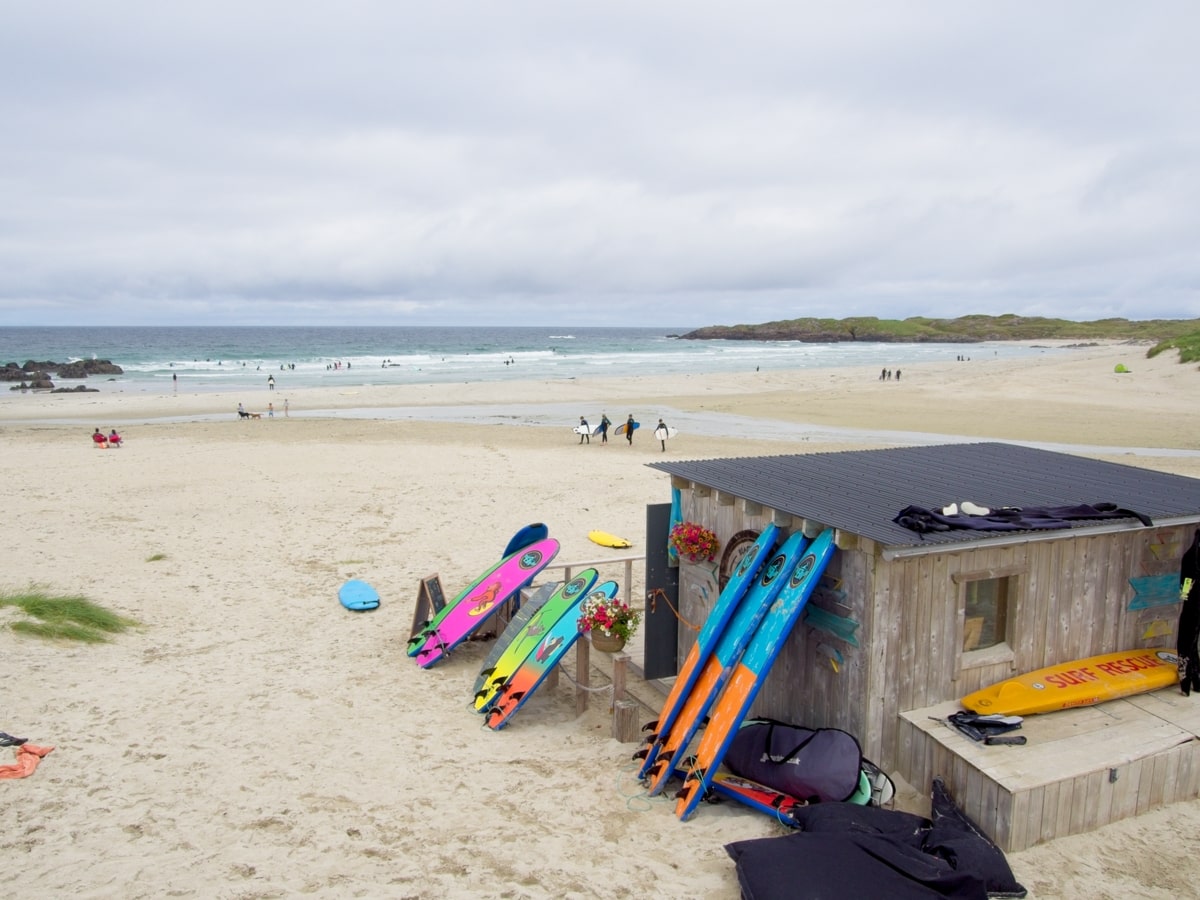
Out About Scotland Guide: Isle of Tiree
The Isle of Tiree is a sunny and windswept island in Scotland’s Inner Hebrides. At just 30 square miles in size, it’s certainly not the largest island, but it’s one that thousands of tourists flock to each year to experience its golden sand beaches, crystal clear waters, and peaceful setting.
Tiree has one of the highest annual sunshine totals in the United Kingdom at around 1,500 hours, and the island is blessed with warm, sunny days from early spring to late summer. It may be small, but this is an island that’s packed with tourist attractions and activities.
With regards to Tiree’s beaches, the highlights are Gott Bay, Balephetrish, and Crossapol, which are all enormous and have exceptionally clean sand, and Balephuil, which is ideally positioned to benefit from Atlantic winds, making it a prime location for windsurfing.
There’s another beach at Scarinish which is tiny but rounded by harbour walls, making it a great place to take younger children. There’s also a village shop and a pub nearby, so visitors will have no problem getting food and drinks for a family beach day.
Many people travel to Tiree every year for the Tiree Music Festival and the Tiree Wave Classic (the longest-running professional windsurfing event in the world), both of which showcase the island’s natural beauty and culture.
Despite the popularity of these events, Tiree rarely feels overcrowded or overly touristy, making it a genuine hidden gem amongst the west coast islands and a perfect destination for Brits who want a summertime beach holiday without the hassle of travelling overseas.
I would personally rank Tiree as being the best Scottish island to visit without a car, as the roads, while narrow, are in good shape and there are very few hills, which makes the island perfect to explore on a bike.
Isle of Harris
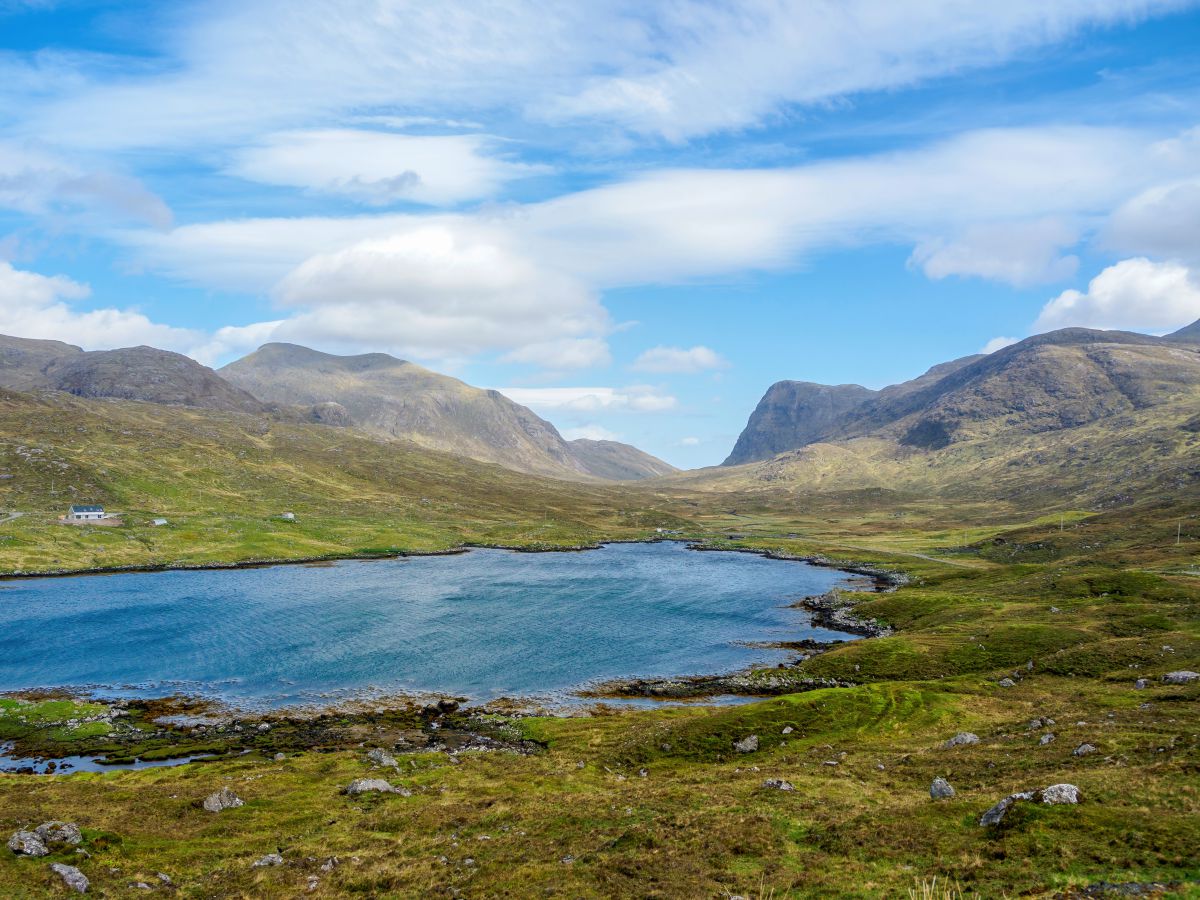
Out About Scotland Guide: Isle of Harris
The Outer Hebrides, a.k.a. the Western Isles, are a group of islands roughly 30 miles west of the Scottish mainland. Although there are more than 70 of these beautiful islands, only 15 are inhabited, the largest of which is Lewis and Harris.
Lewis is relatively flat and has large areas of open moorland, while Harris is far more mountainous and also boasts some of the best beaches in the Hebrides; in fact, I’d say it easily ranks in the top three most beautiful islands to visit in the whole of Scotland.
Heading into North Harris, there are several mountains waiting enticingly for adventurous hikers, the most famous of which is Clisham, which is the highest mountain in the island chain.
Moving west takes us to the North Harris Eagle Observatory and the fantastic trail through the Uisgneabhal Mòr, Teileasbhal, and Stuabhal mountains, while the far western point of North Harris is the location of Hushinish and a peninsula that’s renowned for its remote beaches and hidden lochs.
In South Harris, you’ll find Luskentyre and Scarista, two of the best beaches in the Hebrides. Both are massive, but Luskentyre Beach will leave you speechless. When you visit, you’ll be blown away by the sight of miles of pure white sand stretching into the distance, surrounded by perfect turquoise waters and framed by the rugged Isle of Taransay and the dramatic mountains of North Harris.
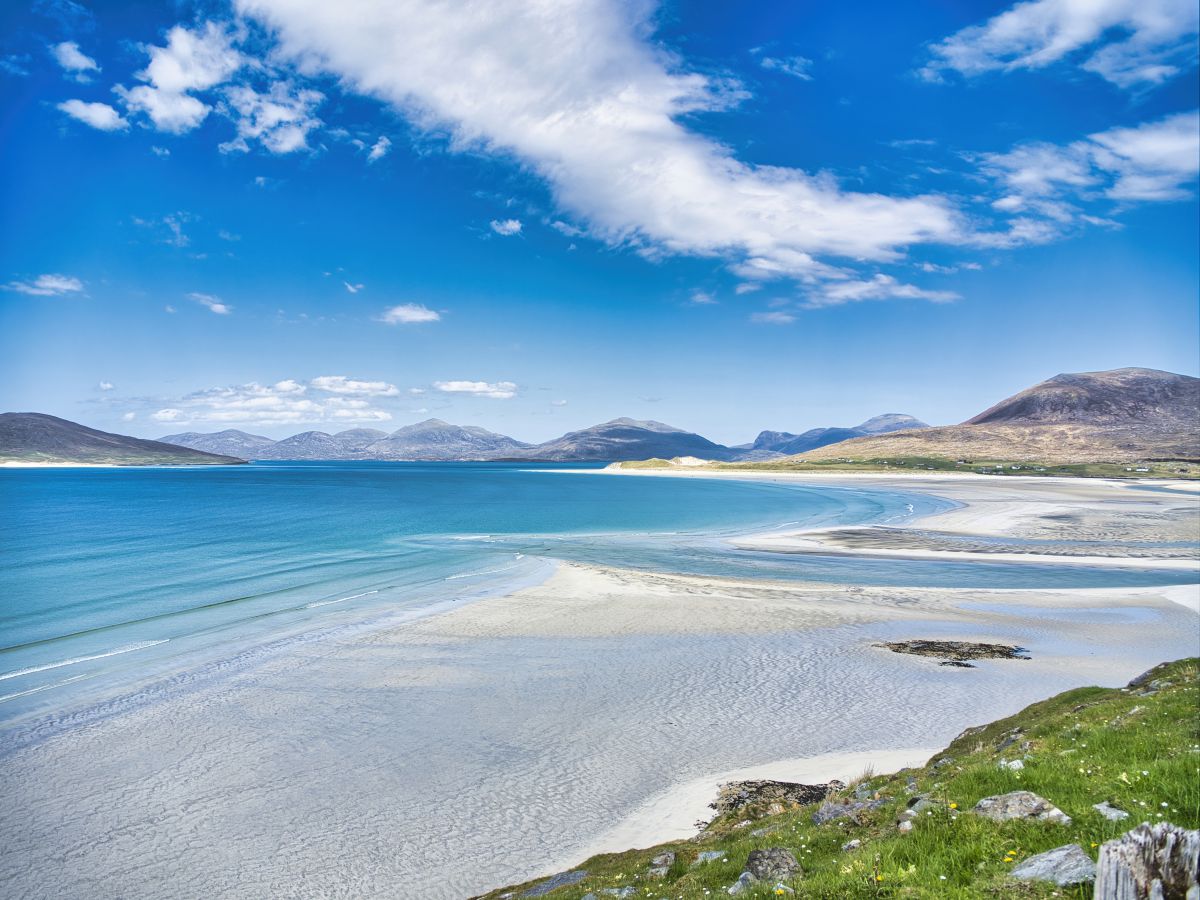
As far as other attractions go, the village of Tarbert on Harris has two major attractions – the Harris Distillery and the Harris Tweed shop – and it’s just a 15-minute drive from the Isle of Scalpay which is a remote wee island with a fascinating historic lighthouse on its eastern corner.
The dramatic scenery and spectacular beaches of the Outer Hebrides have been woven into Rabbie’s 3-day Lewis & Harris small-group tour which takes sightseers across mountains and glens to some of the Western Isle’s top attractions.
Starting in Inverness, the mini-coach heads to the pretty village of Ullapool before catching a ferry to Stornoway, the capital town of the Outer Hebrides. From there, you’ll visit a historic blackhouse (a traditional thatched island home) before exploring the mysterious Callanish Standing Stones and basking in the stunning scenery of the white sands of Luskentyre Beach.
To find out more about the Lewis, Harris & Outer Hebrides 3-day tour, visit the Rabbie’s website.
Isle of Barra
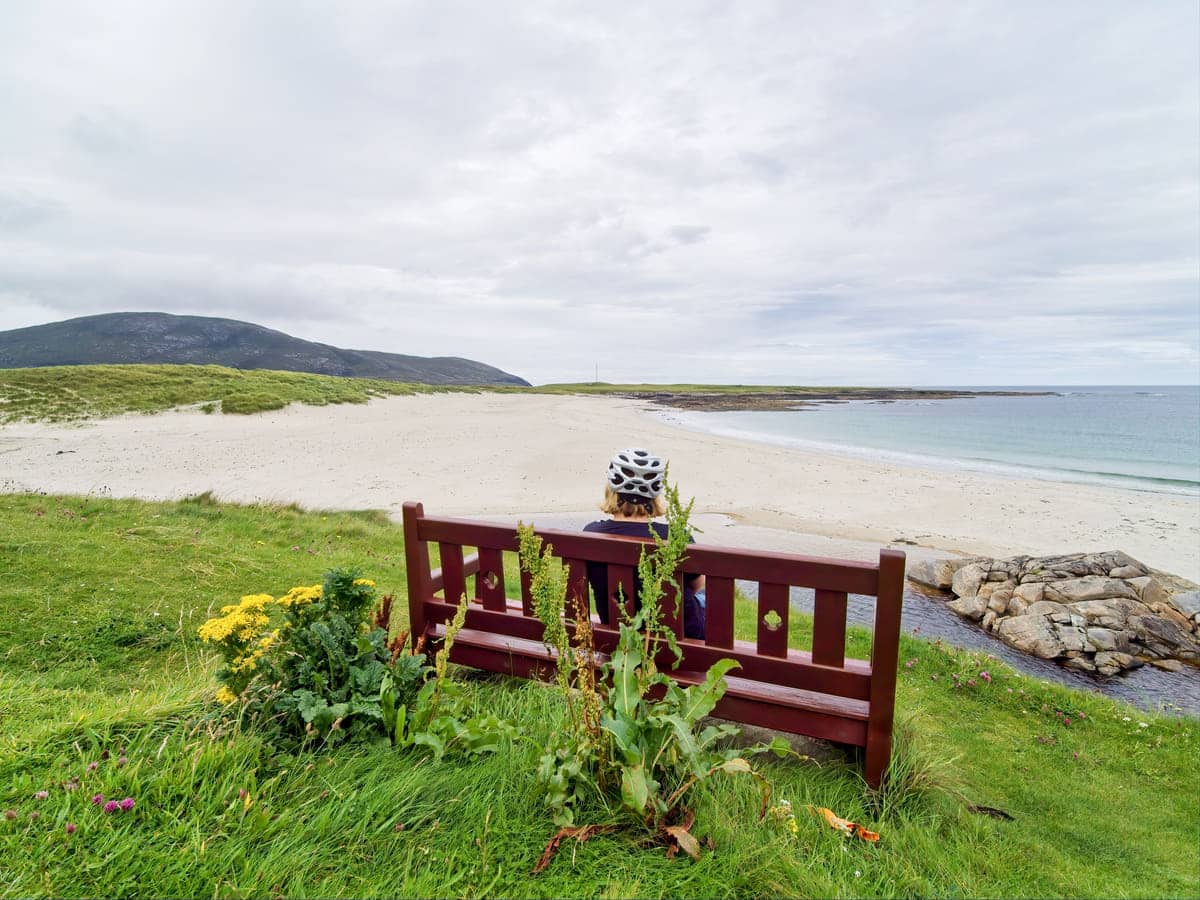
Out About Scotland Guide: Isle of Barra
The Hebridean Way, a 185-mile touring route that takes visitors across ten stunning islands, starts on the Isle of Vatersay, the most southerly inhabited island of the Outer Hebrides, and crosses a causeway to Barra, often referred to as ‘The Gem of the Outer Hebrides’.
Although much smaller in size than Harris and Lewis, Barra is an equally popular island on the touring route as it offers an abundance of activities and attractions. A visit to this 8 x 5 mile island is guaranteed to charm all visitors thanks to its white sand beaches, superb walking trails, and opportunities to walk around the coast and watch the thriving populations of marine life, which include dolphins and whales.
Getting to Barra is simple thanks to ferry terminals at the northern and southern ends of the island, as well as a unique airport on Traigh Mhor beach. This airport is tiny, yet it has become something of a tourist attraction in its own right due to the fact that it’s only accessible when the tide retreats, making it the only beach airfield of its kind in the world.
Tourists looking to unwind can do so on the island’s beautiful northern beaches of Traigh Eais and Eoligarry, while those seeking a more active getaway will find the east coast’s landscape of rolling hills and grasslands ideal for cycling.
Meanwhile, the island’s interior is remote and hilly, providing a respectable challenge for experienced walkers who wish to tackle hills like Heaval. It’s well worth the strenuous ascent of 1,260 feet for the breathtaking panoramas at the top, but hikers need to prepare for frequent ferocious winds that blow in from the Atlantic.
Isle of Rum
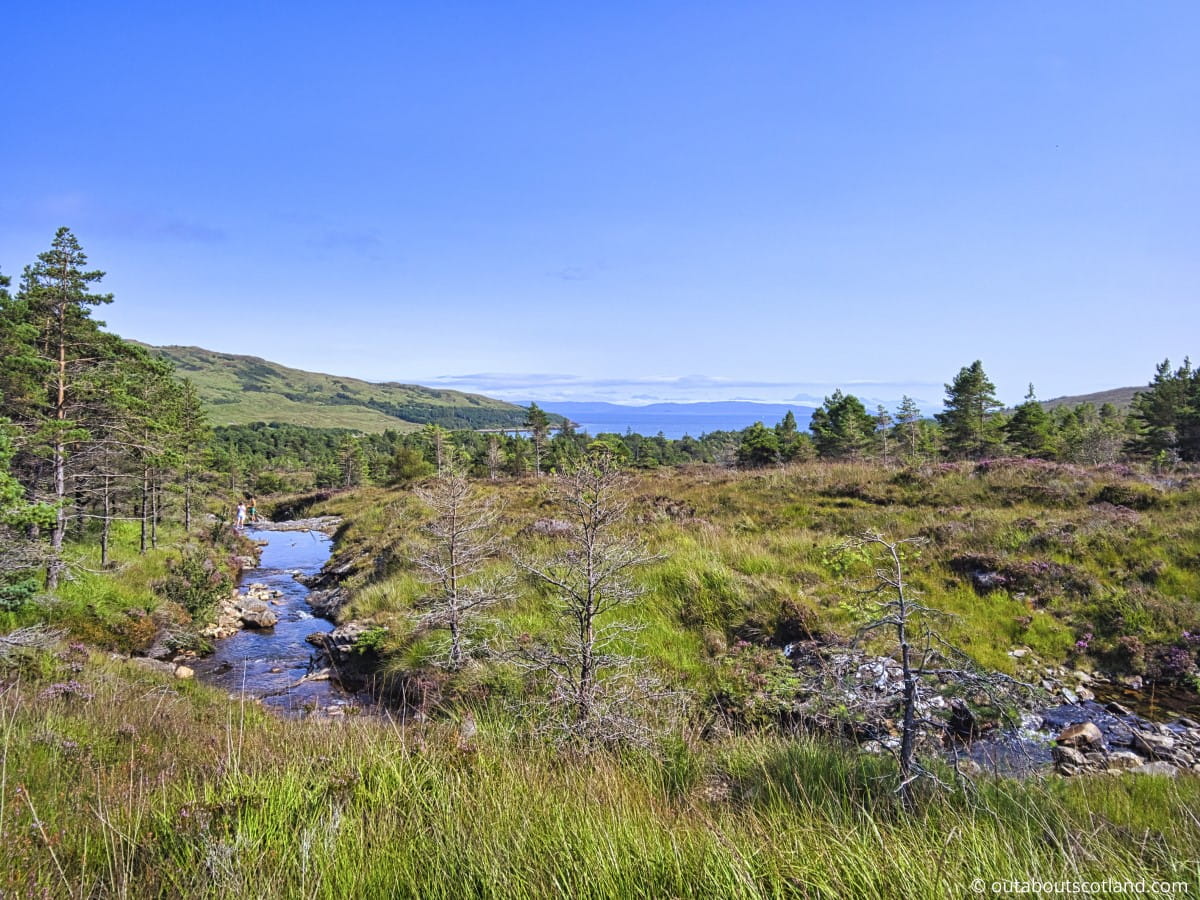
Out About Scotland Guide: Isle of Rum
The Isle of Rum is a remarkable destination and one that’s begging to be explored. Covering 40 square miles, the island is part of Scotland’s Small Isles, which are comprised of Canna, Eigg, Muck, and Rum. Rum is a National Nature Reserve under the stewardship of Nature Scotland and, as such, is a veritable paradise for eco-tourists.
Animals such as golden and sea eagles, Manx shearwaters, otters and seals, and more than 900 red deer call this place home, and visitors will have the opportunity to observe them all in their natural habitats.
Kinloch, the island’s small fishing village and the first sight you’ll encounter due to the ferry dock at Loch Scresort, is an excellent starting point for hikes into the dramatic Cuillin ridge, which lies to the south.
The small community hall at Kinloch is the perfect place to start your adventure, as there’s a gift and food shop, a café, the Rum Bunkhouse (the central accommodation on the island), a campsite, public toilets, and a visitor centre, all of which are managed by the Isle of Rum Community Trust.
You can’t drive a car on Rum, but you can walk or ride a bike around the island and see everything it has to offer. Starting in Kinloch, you can access the island’s west and north coasts, as well as the Cuillin Mountains.
As you head out of the settlement, be sure to take a quick look at the 19th-century Kinloch Castle, originally built for the wealthy Sir George Bullough but now sadly abandoned. Though it’s currently closed to the public, it’s quite a sight and makes for a fantastic photo opportunity.
Isle of Benbecula
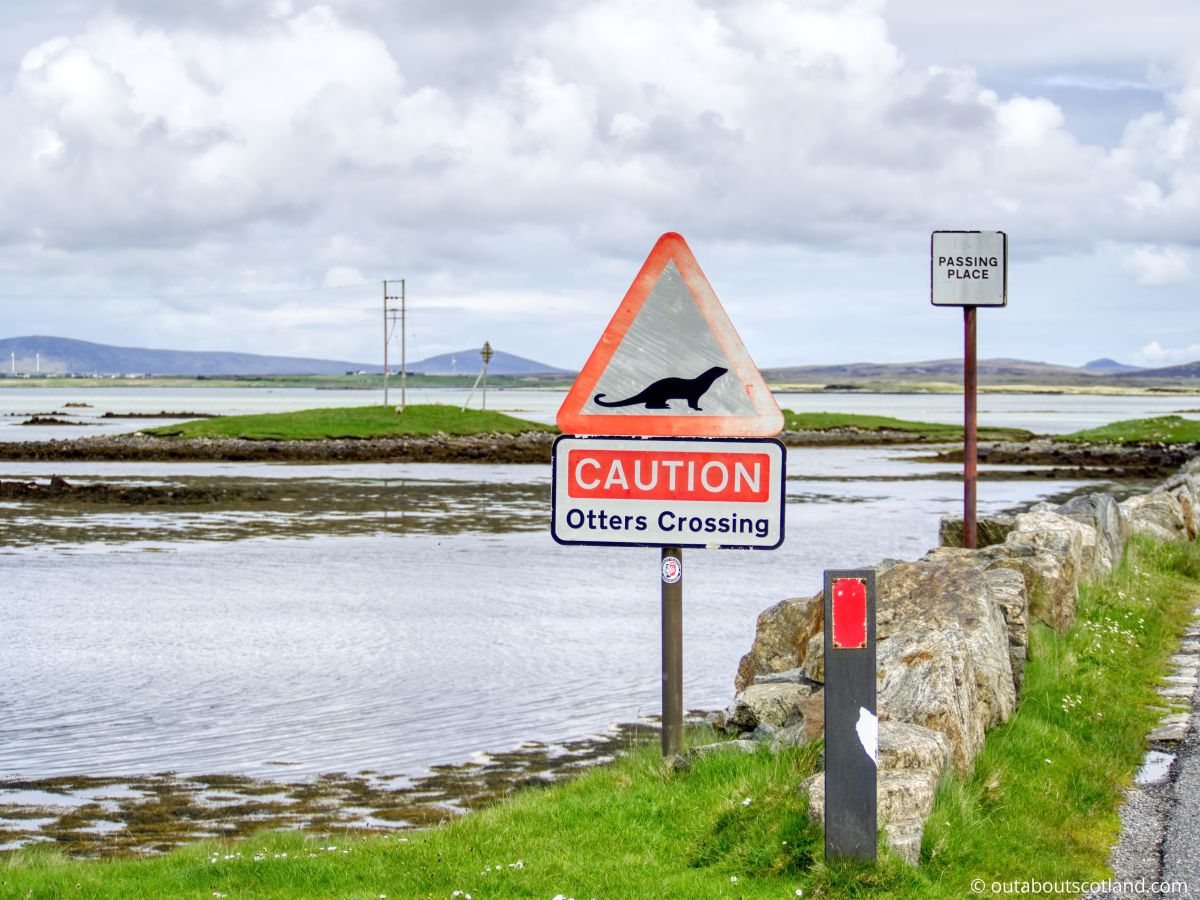
Out About Scotland Guide: Isle of Benbecula
Benbecula is a small island situated between North and South Uist. While the majority of tourists tend to breeze past it as they follow the Hebridean Way, those who take the time to explore the island will be rewarded with breathtaking views from start to finish.
Benbecula is six miles from north to south and eight miles from east to west, and it’s characterised by a flat moorland landscape dotted with dozens of lochs and a rugged coastline scarred with countless sea inlets.
On the west coast, visitors will find white sand beaches that are easily accessed off the B892 (the western ring road), while the east coast is much more secluded with few roads but an even more scenic landscape.
Due to Benbecula’s location, it has a unique climate, with temperatures that generally stay under 17°C even on the warmest days. On the plus side, the roads that run through Benbecula make it a great base for exploring the North and South Uists, which are easily reachable thanks to causeways that link the islands together.
As far as beauty spots go, the highest point of Benbecula, Reuval Hill, is an absolute must-visit, as the summit presents walkers with a panorama that rivals anywhere else in Scotland. Standing at the trig point, you’ll be presented with a sweeping vista of hundreds of lochans and salt-sprayed sea inlets, as well as the dozens of tiny islets that lie between Benbecula and the Uists.
Much of the island’s infrastructure dates back to its days as a military base, so the main village of Balivanich has everything you will need for a short stay, including a supermarket, bank, cafe, bakery, and takeout.
Benbecula is also home to two other sizable communities: Linaclete and Creagorry. Linaclete has a sports centre with a gym and swimming pool, a gas station, and a large hotel, while Creagorry has a co-op and a large hotel.
Isle of Arran
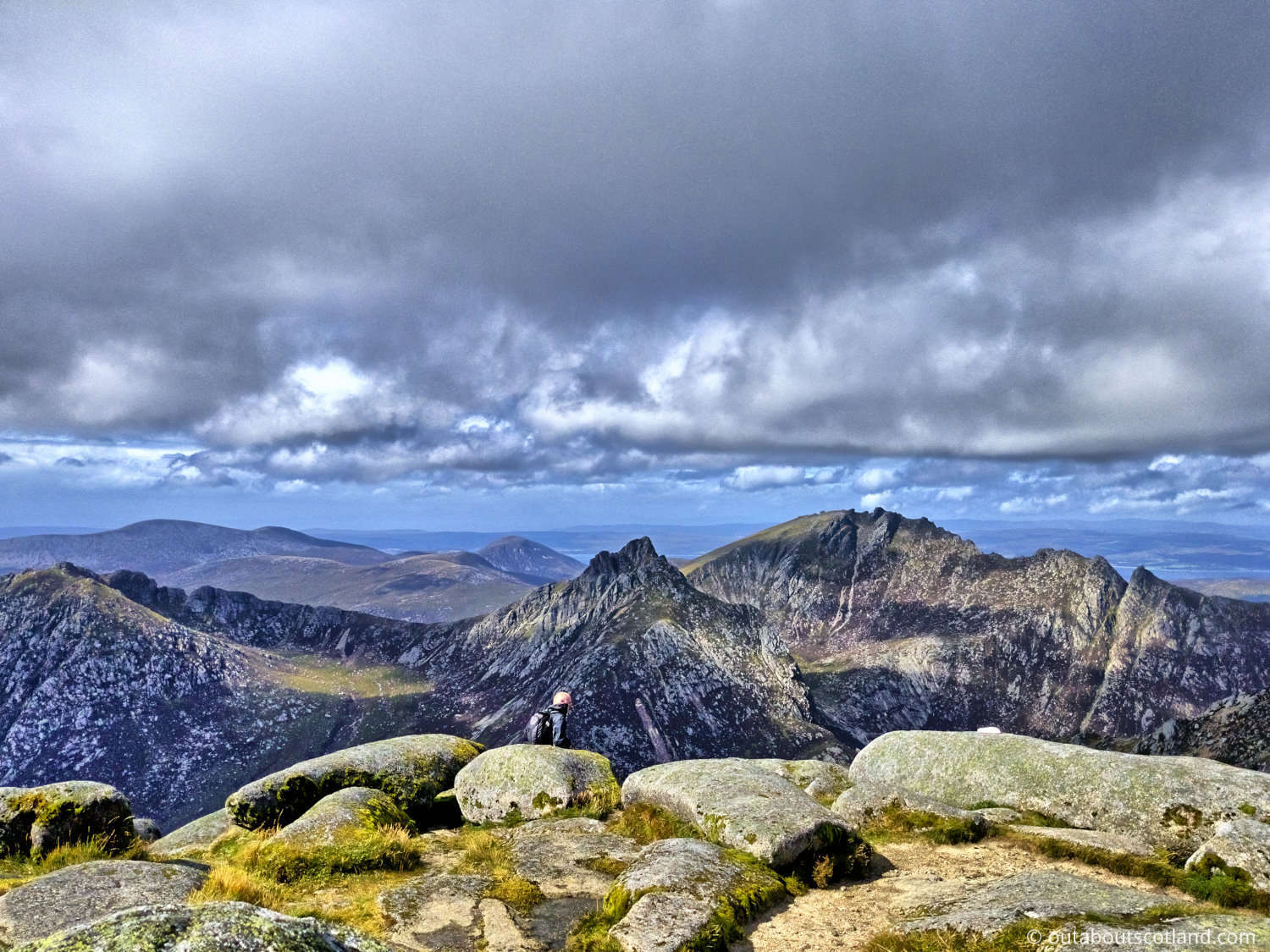
Out About Scotland Guide: Isle of Arran
The Isle of Arran is a small island in the Firth of Clyde on the west coast of Scotland. It’s often called “Scotland in miniature” because of its picturesque setting and diverse landscapes, which include mountains, hills, lochs, woodlands, and beaches.
Getting to Arran is quite straightforward thanks to CalMac ferries operating out of Claonaig and Ardrossan on the mainland. The 30-minute crossing from Claonaig is the fastest way to get to the island, while the journey from Ardrossan to Brodick, Arran’s main town, takes approximately one hour.
While Brodick’s restaurants and beaches certainly don’t disappoint, the real draw is the island’s breathtaking natural scenery, which is perfect for hiking and cycling. The mountainous northern half is a must-visit for avid hikers, but there are plenty of other outdoor activities to enjoy on Arran, including gorge walking, rock climbing, sea kayaking, and canyoneering.
Walkers, in particular, are spoilt for choice with the numerous trails on the island, but the 3-mile route up Goatfell, Arran’s highest peak, is the highlight. The route begins near Brodick Castle and rewards with stunning scenery from start to finish.
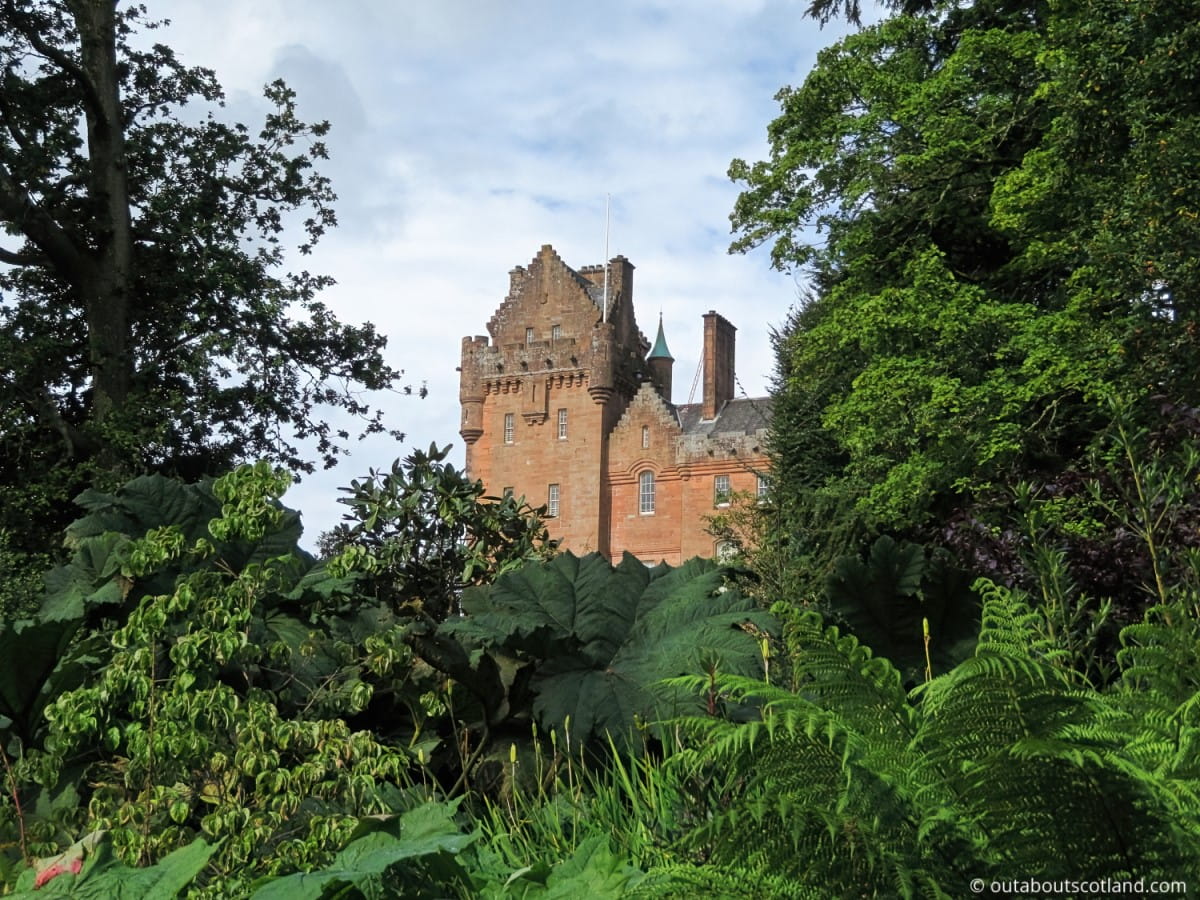
Machrie Moor on the southeast side of the island is another great place to explore, as it’s home to a substantial Neolithic stone circle, while the southern half of the island is home to a number of forests that are easily explored thanks to logging roads that scythe their way through them.
Speaking of roads, all visitors to Arran have to tour the Arran Coastal Way, whether in a car, on a bike, or simply walking. This rewarding touring route is 65 miles long and circles the island in its entirety, offering remarkable views across the Firth of Clyde to the east and the Campbeltown peninsula to the west.
Arran is a must-visit for anyone visiting Scotland, purely because you’ll get to see everything that makes this country so special—untains, lochs, coastlines, castles, forests, and whisky distilleries—in one place.
Rabbie’s Isle of Arran Adventure is a 3-day small-group mini-coach tour that starts in Glasgow and stops at iconic attractions like Culzean Castle and Loch Lomond as well as off-the-beaten-path destinations like the beautiful Kintyre Peninsula on the southwest corner of the Scottish Highlands.
Once on Arran the tour heads to Brodick Castle and the Lagg distillery as well as the prehistoric Machrie Moor standing stones.
To make a booking or find out more information about this tour, visit the Rabbies Isle of Arran Adventure page.
Isle of Islay
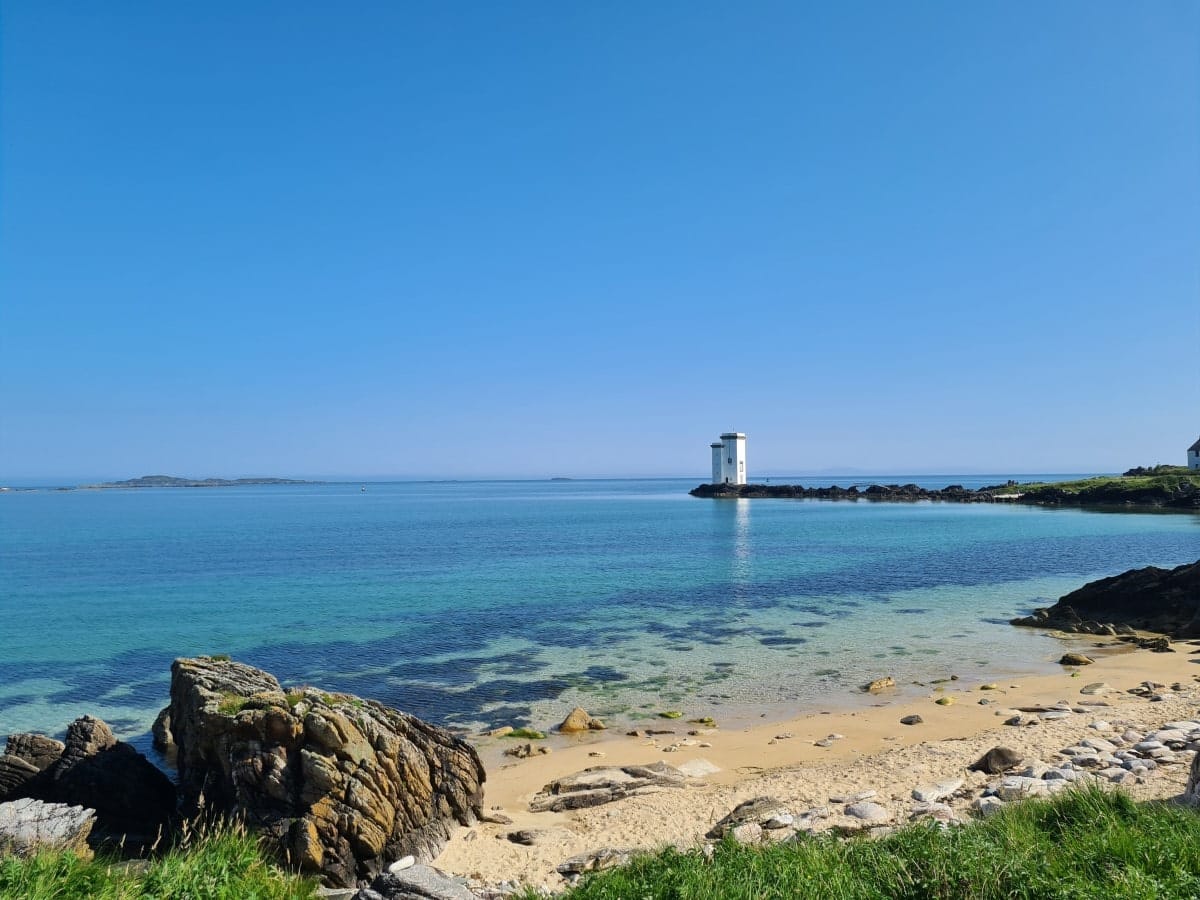
Out About Scotland Guide: Isle of Islay
It is easy to see why the Isle of Islay, the fifth-largest island in Scotland, has been called “The Queen of the Hebrides” by generations of proud locals. In addition to its superb coastline and countless walking trails, the island is home to a wide variety of flora and fauna, as well as distilleries that are world-famous for their delicious peaty flavours.
On the east coast, the landscape rises steeply from the Sound of Islay to the mountain of Beinn Bheigier, which reaches a height of 491 metres, while Claggain Bay and the peninsula at The Oa are unforgettable destinations with spectacular views across clear waters and vast stretches of golden sand.
There are also lots of charming villages on Islay, courtesy of the distilleries they centre around, so if you’re an enthusiast of Bowmore, Port Charlotte, Port Askaig, or Port Ellen, you might like to take a walk around their namesake hamlets.
Many of the distilleries on Islay have tasting rooms that overlook the sea, which are ideal places to soak up the views while sipping a fine dram or two. Bowmore, in particular, has a very good bar that features a terrace overlooking the enormous Loch Indaal, while the Ardbeg distillery has (in my opinion) the best cafe on the island and sea views that look towards Campbeltown on the mainland.
There are heaps of hidden treasures waiting to be found on Islay if you take the time to look for them, the highlight being Finlaggan, the historic home of the ancient Lords of the Isles. After a visit, you might like to drive a few miles north to Port Askaig, where you can then hop on a ferry to the Isle of Jura which is another lovely wee island that sees few tourists yet is extremely pretty.
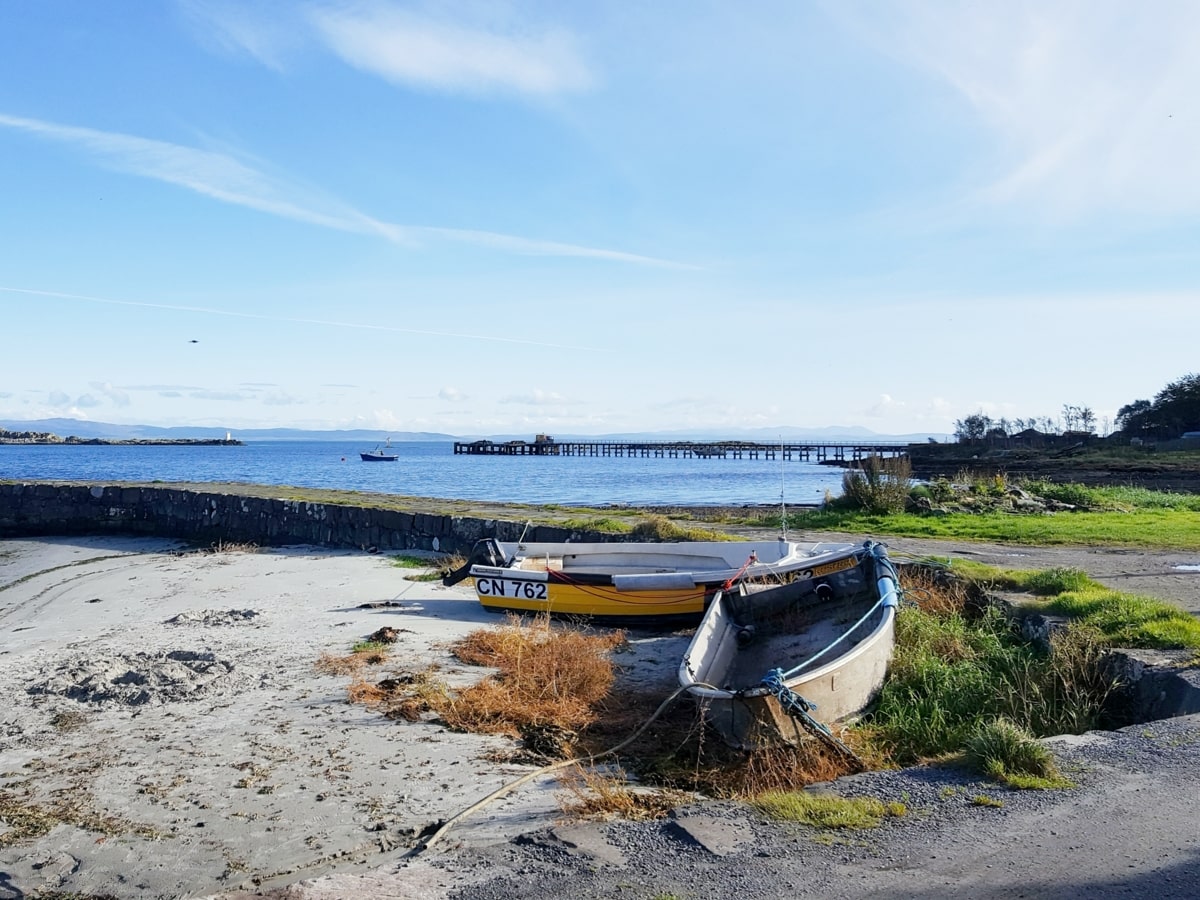
It’s a fact that Islay is one of the best islands in Scotland. Whether you’re a wildlife enthusiast or a beach lover, Islay has something for everyone, and it’s an absolute must-visit for anyone who’s a connoisseur of fine single-malt whisky.
For the tens of thousands of tourists that flock to Scotland for sightseeing tours each year, the Isle of Islay is usually among the top destinations on their itineraries, especially for anyone who loves single-malt Scotch whisky.
There’s so much more to the island than peat-infused spirits though, thanks to a dramatic coastline and some of the best wildlife-watching opportunities in Britain. To really make the most of a trip to Islay, you need to know exactly where to go and what to see, which is where Rabbie’s 4-day Islay & the Whisky Coast tour comes into its own.
Starting in Edinburgh, the expert driver will take you through the Scottish Highlands to Oban, the ‘Seafood Capital of Scotland’, before hopping on a ferry to Islay to see its beautiful rugged coastline and enjoy a wee dram or two at iconic distilleries such as Bruichladdich, Ardbeg, Laphroaig and Lagavulin.
To make a booking or to find out more about the tour, visit the Islay & Whisky Coast tour page on the Rabbie’s website.
Isle of Vatersay
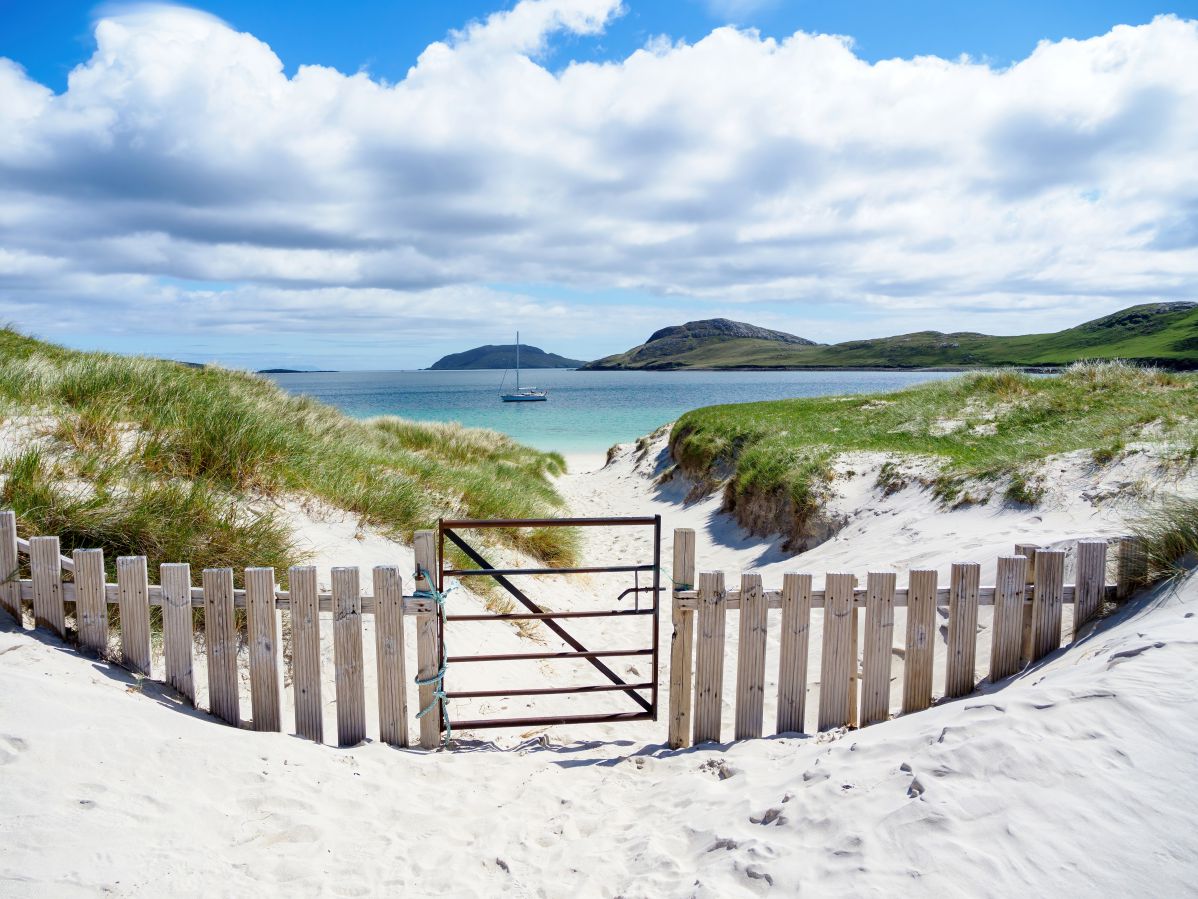
Out About Scotland Guide: Isle of Vatersay
As the most southerly inhabited island of the Outer Hebrides and the most westerly inhabited island in Scotland, you might think that Vatersay is hard to get to. The truth, however, is that it’s very accessible thanks to a 600-foot causeway that links it to Barra and the ferry terminal at Castlebay, making Vatersay an ideal destination for both holidaymakers and anyone starting a tour of the Hebridean Way.
The main draw for visitors are the two beautiful white-sand beaches in the middle of the island: Traigh Shiar and Traigh a Bhaigh. The beaches are tucked into broad bays, making them ideal for a day at the beach thanks to their protection and shallow, turquoise waters, which are reminiscent of a far-flung tropical paradise.
Between the bays is a stretch of flower-filled grassland, called machair, that’s a riot of colour in the summer months, while to the north and south there are hill ranges that offer spectacular views of the surrounding countryside.
Head south from the beaches, and visitors will have a good chance of spotting a variety of birds and marine animals, from seals and eagles to puffins and basking sharks. Binoculars are an absolute must-have for a visit to Vatersay, so if you don’t have a pair yet, check out my buyer’s guide for information on what to look for when buying your next set of optics.
For those looking for a little more than a beach holiday, there are plenty of other attractions to enjoy during a trip to the island. In nearby Castlebay there’s a distillery, a toffee factory, and the famous Kisimul Castle, as well as boat tours that sail to the islands of Sandray, Pabbay, and Mingulay which are a haven for wildlife.
Isle of Eigg

Out About Scotland Guide: Isle of Eigg
The Isle of Eigg is one of the smallest islands in the Hebrides, but it packs a punch when it comes to beautiful landscapes. With a total area of just 12 square miles and a handful of permanent residents, the island manages to have a non-commercialized charm while still offering a warm welcome to tourists.
Located to the south of the Isle of Skye and north of the mainland Ardnamurchan Peninsula, Eigg is one of the four small islands, which include Canna, Muck, and Rum. Though small, the island boasts a varied landscape that ranges from shingle beaches on the coastline to sheer cliff faces in its most northerly and southerly regions.
An Sgurr, a huge mountain ridge to the south, and Beinn Bhuidhe, another massive ridge to the north, tower over the island and offer hill climbers an enjoyable hike, while cyclists are guaranteed an enjoyable ride from the ferry terminal at Galmisdale to the beaches on the northwest end of the island.
If you’re hoping to find overnight accommodation, you’ll find a small selection of B&Bs and self-catering houses on Eigg, but availability is often very limited, so it’s a good idea to book early.
Calmac ferries make twice-daily sailings from Mallaig to the island in the summer, making it convenient to visit as a day trip if lodging is unavailable; however, tourists are not permitted to bring cars onto the island, limiting their mobility to the extent to which they can cycle or walk.
Visitors to Eigg will find a few amenities, such as a café near the ferry jetty, but other than that, there are very limited facilities. Nonetheless, the island is a wonderful place to visit and is highly recommended for families, couples, and solo travellers alike.
Touring The Most Beautiful Islands in Scotland
If you’d like to visit Scotland’s islands on a small group tour I highly recommend Rabbie’s. This tour operator has been running since 1993 and exclusively uses mini coaches that hold a maximum of 16 people so you’re guaranteed to make new friends on each trip.
All Rabbie’s drivers are experts in Scotland, so you’ll hear a few fascinating and hilarious tales as you make your way around the most beautiful parts of the country. To book a sightseeing tour of the Scottish Islands or to find out more information about them, check out the Rabbie’s website.
Frequently Asked Questions
What is Scotland’s prettiest island?
Scotland is home to some of the most beautiful islands in the world. From the wild and rugged landscapes of the Outer Hebrides to the picturesque beaches of Tiree, each island has its own unique beauty. That being said, if you’re looking for Scotland’s prettiest island, you won’t go far wrong with Harris & Lewis, the most northerly of Scotland’s Western Isles.
Which Scottish islands should I visit?
Scotland is a country with a wealth of history and beautiful landscapes. It has over 790 islands scattered across its coasts, but only a handful of these are inhabited. The best of these islands are located in the Inner and Outer Hebrides.
The Inner Hebrides are close to the mainland and home to some of the country’s most iconic locations, like the Isle of Skye and the Isle of Mull.
The Outer Hebrides are located off the west coast and are home to white-sand beaches, remote villages, and some of the best wildlife-watching experiences in the country. The Isles of Harris and Lewis and the Uist Islands are particular highlights.
Which Scottish island has the best beaches?
Scotland is home to many beautiful islands, each with its own unique attractions. One of the most popular destinations for beach lovers is the Isle of Tiree.
This island is known for its stunning sandy beaches and its flower-covered grasslands, making it a must-visit for anyone looking for a quiet beach getaway in Scotland.
One of the most popular places on Tiree is Crossapol, a gorgeous white-sand beach situated on the east side of the island. Another top beach is Balephuil, which is the most popular spot for watersports such as kitesurfing and windsurfing.
What is the famous island off the coast of Scotland?
The famous island off the coast of Scotland is the Isle of Skye. Located in the Inner Hebrides, it’s the largest and busiest island in the archipelago. The Skye Bridge connects Skye to the mainland, and it is well-known for its stunning scenery, charming villages, and incredible wildlife.
Landscapes such as the Quiraing and the Storr are frequently featured on travel websites, hence Skye’s worldwide fame.



